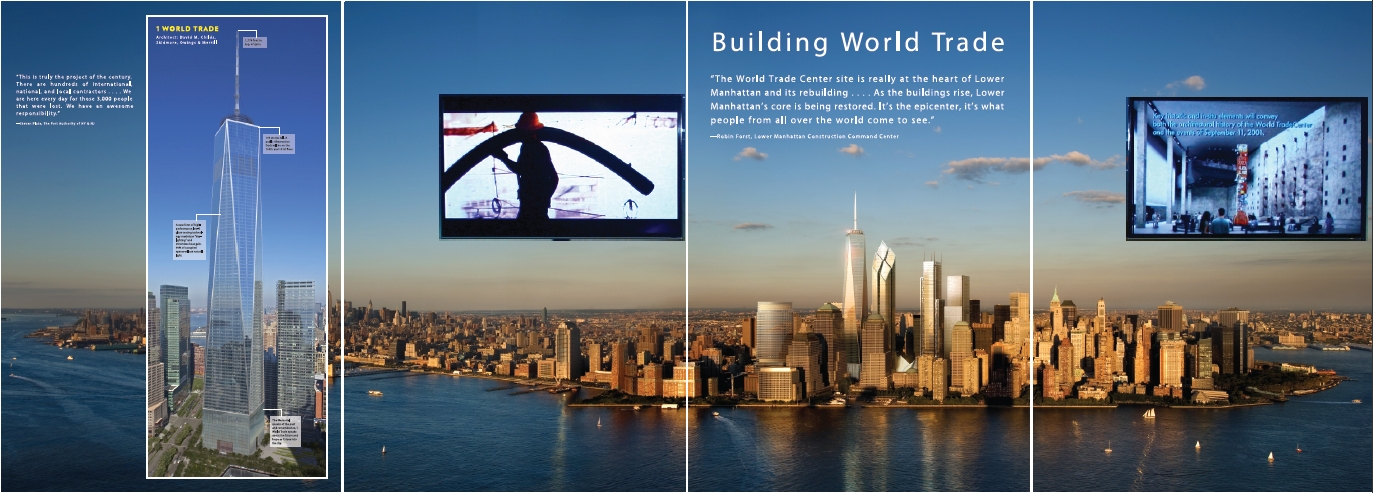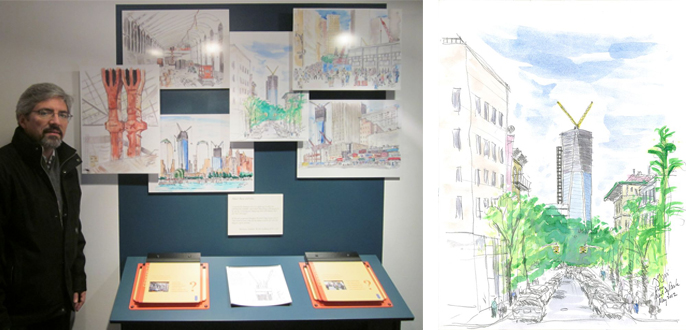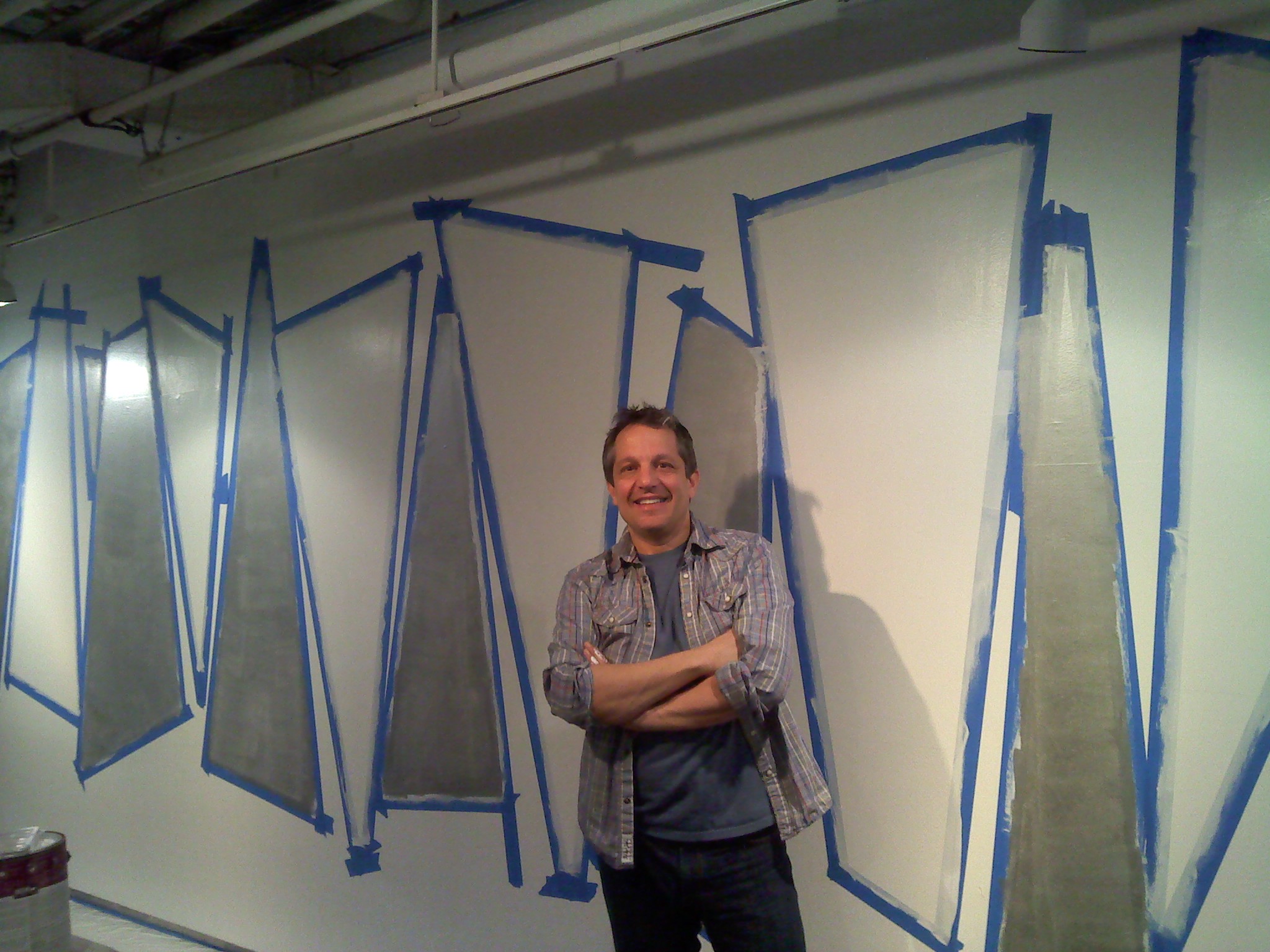ALUMNI INNOVATORS
 Exhibit designer Daniel Schnur proposed to the Tribute Center that graphics be illuminated by a huge light-box. “With a limited budget and timeframe it was a challenge, but, in the end, we developed a very simple plan that worked out perfectly,” says Schnur.
Exhibit designer Daniel Schnur proposed to the Tribute Center that graphics be illuminated by a huge light-box. “With a limited budget and timeframe it was a challenge, but, in the end, we developed a very simple plan that worked out perfectly,” says Schnur.
The 9/11 Tribute Center, created by the September 11th Families’ Association to share the personal stories of those directly affected by the World Trade Center (WTC) bombings, recently opened an ongoing exhibition, Building World Trade. The exhibit shows what the entire site will look like when finished as well as the process of getting there. As the show was coming together, these three Pratt graduates discovered they shared an alma mater.
Dan Schnur (B.I.D. ’79), the exhibit’s designer, turned the Tribute Center’s ideas into a three-dimensional reality, developing the exhibit concept, and managing fabrication and installation.
Tom Grassi (B.Arch. ’85), project manager for the WTC Transportation Hub, chronicled the construction of the WTC in hand-drawn sketches featured in the exhibit.
Tim Cramer (B.Arch. ’86), an audio-visual media developer, created the video installation and oral history stations.
Did 9/11 have a personal resonance for you?
TG: Very much so. I was on the 82nd Floor of Tower One when it was hit by the first plane that morning. I was still inside that building when Tower Two collapsed and only got out with the help of a lot of firefighters who knew exactly what was going on, yet made the decision to stay behind. Ten or fifteen minutes after I made it out, I watched Tower One collapse. Within a day or two, I was asked to come back to start working to figure out what we were going to do next. I was very happy to do so, and I'm still there.
TC: Yes, it did. While at Pratt, I visited the WTC several times with other students—we had discussions, debates—marveled at the sheer size, the fact that one could stand at the base and look straight up. One Pratt professor stated that the original design would not have worked had it been just one large tower but the genius came with generating two twin buildings. The plaza, the concerts, the high-wire artist Philippe Petit, the observation deck, the daily gathering of working people—all there in relative peace. On 9/11 I was living at 2nd Avenue and 6th Street, listening to 1010WINS when I found out. Looking out the window I could see the billowing smoke. When the towers came crushing down, I somehow had lost faith in mankind. I absolutely would not believe that those buildings were demolished in a matter of seconds. For one entire week, downtown was at a standstill as if the same day was playing over and over again.
 The Tribute Center asked Grassi to sketch additional views for the exhibit showing the life around the site while construction took place, from the commercial life to the spiritual life.
The Tribute Center asked Grassi to sketch additional views for the exhibit showing the life around the site while construction took place, from the commercial life to the spiritual life.
What did you find rewarding about creating this exhibit?
TG: Since a 1984 class at Pratt with Barbara Carr, I have enjoyed sketching on-site wherever I travel. As work really got going at the WTC, on weekends or after work, I began drawing the construction activities and progress. It was a moment of great coincidence that, as I approached the Tribute Center with a collection of my sketches looking for a vehicle by which to share them, they were just starting to plan for what became the Building World Trade exhibit. The timing was perfect.
The Building World Trade exhibit is great. I know there is a perception that it has taken a long time to complete the construction, and sharing this information with the public helps explain some of the complexities of what it takes to make the project happen. Additionally, a tremendous amount of construction has been going on below the street level that is not readily visible to the general public. This spring, the transportation hub will be coming up above grade level. It's going to be an amazing piece of architecture.
How does your Pratt education inform the work that you do now?
 Daniel Schnur designed the exhibit Building World Trade
Daniel Schnur designed the exhibit Building World Trade
DS: In my design work I am continually met with the challenge of how to present an assortment of concepts and artifacts in a cohesive way to educate, entertain, and capture the interest of museum visitors.
I often recall the basics I learned in freshman Form and Space class with Bill Fogler and later in 3D-design classes. I consider dominant, sub-dominant, and subordinate elements; contrast of form and color; form and function; line and volume; geometric and organic shapes; the emotional response; the integrity of materials … and after all this consideration, I feel free to follow my instinct and do something else, bend the rules, have fun and take a few chances.
TG: I had a great experience at Pratt and nothing but fond memories whenever I'm back to the campus now.
Among many other things, it exposed me to faculty who were doing lots of different things with their lives. I think that spirit has followed with me, as I can be a designer, architect, manager, educator, and still an artist, enabling me to contribute to the exhibit.
TC: My education and experience at Pratt informs and influences me greatly to this day. Although I now work in a very different discipline (time-based media) the approach and critical thinking that I learned carries across fluently. I am continuously recalling and utilizing studies in composition, balance, form, and proportion. Especially enlightening was being influenced by artists of all disciplines working in varying media.
Text: Bay Brown
Images: Courtesy of 9/11 Tribute Center

 Gateway Editors
Gateway Editors